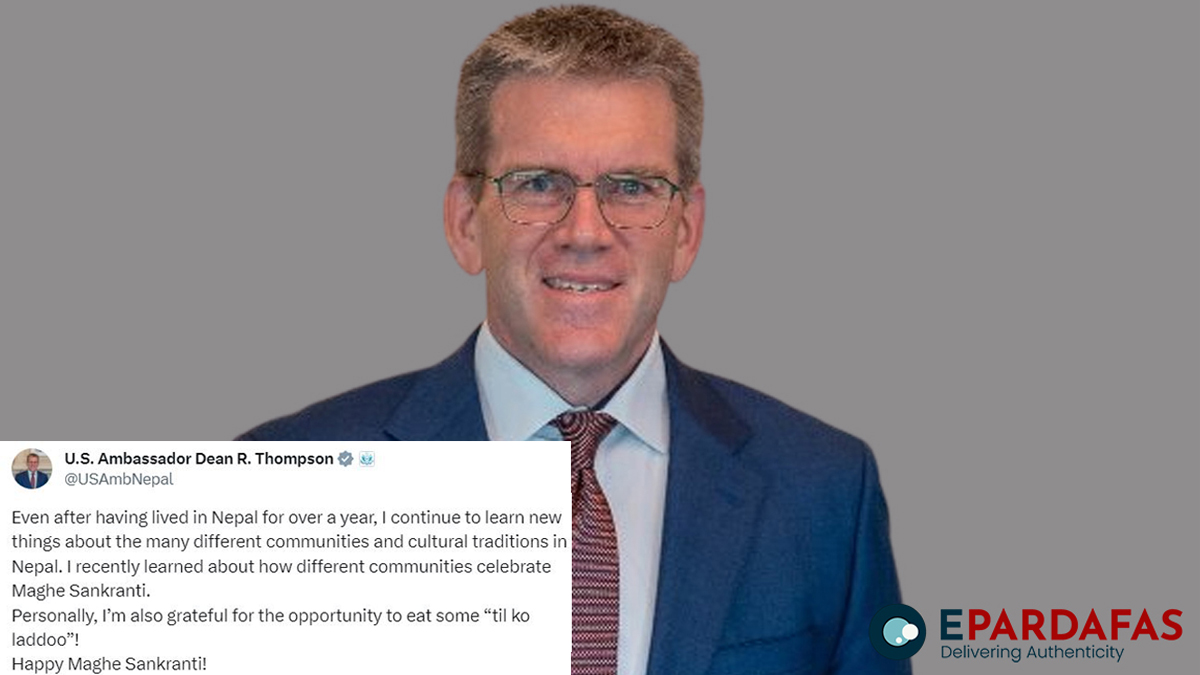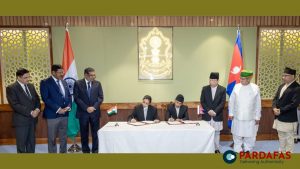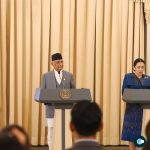
Living, Learning, and Loving Nepal: Envoy Thompson Cheers Maghe Sankranti, Enjoys Diversity
In a heartwarming gesture that reflects the U.S. Ambassador’s deep appreciation for Nepali traditions, Dean R. Thompson took to the social media platform ‘X’ on the auspicious occasion of Maghe Sankranti, also known as Maghi. The festival, celebrated on the first day of Magh in the Bikram Sambat calendar, holds great cultural significance as it marks the transition from winter to warmer days.
Ambassador Thompson, who has been residing in Nepal for over a year, expressed his ongoing fascination with the diverse communities and cultural traditions that enrich the Nepalese tapestry. In a message shared on ‘X’, he noted, “Even after having lived in Nepal for over a year, I continue to learn new things about the many different communities and cultural traditions in Nepal. I recently learned about how different communities celebrate Maghe Sankranti. Personally, I’m also grateful for the opportunity to eat some “til ko laddoo”! Happy Maghe Sankranti!”
Even after having lived in Nepal for over a year, I continue to learn new things about the many different communities and cultural traditions in Nepal. I recently learned about how different communities celebrate Maghe Sankranti.
Personally, I’m also grateful for the opportunity…— U.S. Ambassador Dean R. Thompson (@USAmbNepal) January 15, 2024
Maghe Sankranti, a day for taking holy dips in rivers and ponds, worshiping at various temples, and relishing traditional delicacies like ghee, yam, khichadi, Chaku, and sweets made of sesame and molasses, has been marked as a public holiday by the government. The festive atmosphere permeates the air as communities across Nepal engage in joyous celebrations to bid farewell to the gloomy winter.
Astrologically, Makar Sankranti holds special significance, as it signifies the sun’s shift into the northern hemisphere, marking the beginning of longer days and shorter nights. According to astrological charts, the sun moves from the tropic of Sagittarius to the tropic of Capricorn on this day.
Religious texts such as ‘Bhabisya Puran’ and ‘Dharma Sindhu’ attribute special blessings and a robust body to devotees who observe the festival with adherence to rituals. The Tharu community, known for its vibrant culture, observes Maghi with immense fanfare and gaiety over five consecutive days.
In the Tarai districts, Maghe Sankranti takes on the form of the festival of bath, known as Nahan, where people engage in cleansing rituals to purify themselves. The diversity of customs and rituals associated with Maghe Sankranti reflects the rich cultural tapestry of Nepal, encompassing the traditions of the Khas-Arya, Magar, Rai, Tharu, Limbu, Newar, Gurung, Maithili, Kumal, and other tribes.
Maghi is not merely a festival but a testimony to the cultural identity and diversity of Nepal. It validates the ethnic identity of different communities, showcasing traditional institutions, customs, and the coexistence of cultural diversity that contributes to national unity.
As Ambassador Dean R. Thompson partakes in the festivities and extends his warm wishes, his embrace of Nepali traditions echoes the spirit of unity in diversity, fostering strong diplomatic ties between the United States and Nepal. May this Maghe Sankranti festival bring joy, prosperity, and continued cultural exchange between these two nations.
- Health Insurance Now Covers Nearly Half of Gandaki Province’s Population
- Mercure Kathmandu Extends Financial Support to Cancer Care Nepal
- DRRMNC Urges Swift Action to Tackle Forest Fires and Accelerate Reconstruction Efforts
- Nepal Observes People’s Movement Day to Commemorate Restoration of Democracy













Comments